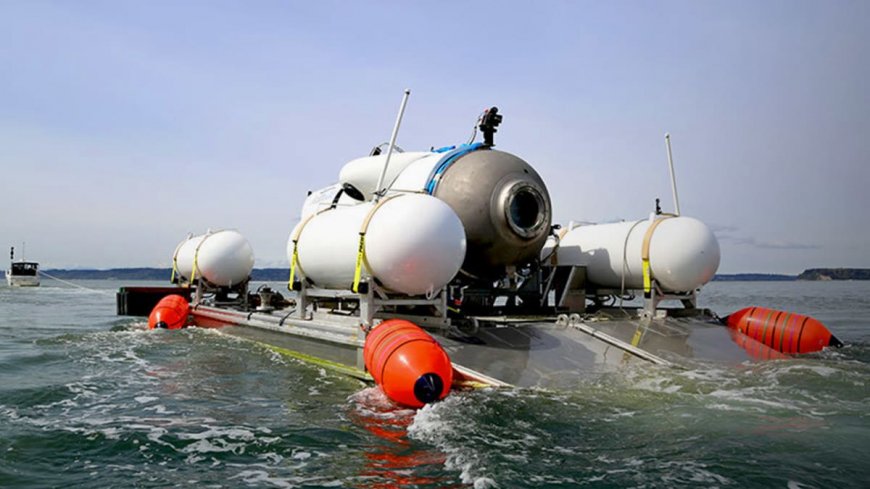Update: Coast Guard Confirms 'Catastrophic Implosion' Close to Titanic Site Is Titan Submersible
Is the Titan 'implosion theory' on target?

UPDATE: The OceanGate Titanic tourist submersible saga appears to have ended in tragedy after the company said it believes that all five crew members have perished.
“We now believe that our CEO Stockton Rush, Shahzada Dawood and his son Suleman Dawood, Hamish Harding, and Paul-Henri Nargeolet, have sadly been lost,” the company said in a statement.
DON’T MISS: This Millionaire Pulled Out of the Titanic Tour Due to Safety Reasons
“These men were true explorers who shared a distinct spirit of adventure, and a deep passion for exploring and protecting the world’s oceans,” the statement noted. “Our hearts are with these five souls and every member of their families during this tragic time. We grieve the loss of life and joy they brought to everyone they knew.”
The U.S. Coast Guard confirmed the news in a press conference Thursday, stating the Titan submersible is likely to have experienced a “catastrophic explosion.”
The remains of the Titan were discovered Thursday morning approximately 4,000 meters below sea level and about 500 meters from the Titanic, U.S. Coast Guard Rear Admiral John Mauger told reporters. The Titanic which sank in April 1912, about 400 miles off the coast of Newfoundland.
"The debris field here is consistent with a catastrophic implosion of the vehicle . . . and the catastrophic loss of the pressure chamber," Mauger said.
More Trending Social Media News:
- Mr. Wonderful Asks Social Media for Business Pitches -- and the Results are Laughable
- Why One Late-Night Host Has Seemingly Taken Over Reddit
- Elon Musk Takes a Shot at Mark Zuckerberg's Twitter Rival
It wasn’t apparent if the explosion occurred shortly after descent or later in the week, Mauger noted. He also stated there was probably no connection between reported pinging noises and the debris area on the ocean floor.
“Upon this determination, we immediately notified the families,” Mauger added.
Engineering experts said the “debris field” found by the Horizon Arctic’s ROV offshore support vessel confirmed it was the wreckage from the OceanGate submersible.
“The initial thing we found was the nose cone, which was outside the pressure hull,” said undersea expert Paul Hanken at the press conference. “We then found a large debris field; within that large debris field we found the front end bell of the pressure hull,” Hanken said. “That was the first indication that there was a catastrophic event.”
The Titan submersible set off from Newfoundland on June 16, looking to descend approximately four miles to investigate the wreck of the Titanic.
On June 18, the Titan launched its descent to the Titanic, and within hours, the surface vessel lost communications with the submersible.
The Coast Guard said its rescue team will remain active while it further investigates the incident.
As rescuers expand their search for the “Titan,” the submersible lost at sea in the North Atlantic near the wreck of the Titanic earlier this week, the U.S. Coast Guard reported finding a “debris field” in the area.
“A debris field was discovered within the search area by an ROV near the Titanic,” the Coast Guard tweeted at 11:48 AM on Thursday, June 22. “Experts within the unified command are evaluating the information.”
DON’T MISS: Titan Submersible: Everything You Need To Know
The emergence of a debris field gives some credence to the “implosion” theory, which speculates that severe water pressure could trigger a massive implosion, a scenario that would lead to loss of life immediately for all five travelers on board the Titan. The vessel is is owned and operated by OceanGate Expeditions.
That number would include chief executive officer Stockton Rush, U.K. billionaire Hamish Harding, French adventurer Paul Henry Nargeolet, and Pakistani businessman Shahzada Dawood and his son, Sulaiman.
More Trending Social Media News:
- Mr. Wonderful Asks Social Media for Business Pitches -- and the Results are Laughable
- Why One Late-Night Host Has Seemingly Taken Over Reddit
- Elon Musk Takes a Shot at Mark Zuckerberg's Twitter Rival
The Titanic lies between 3,500-to-3,800 meters below the Atlantic 380 miles away from Newfoundland. If the Titan descended to 3,800 meters below sea level, the water pressure would be 376 times greater than the pressure generated by the Earth’s atmosphere, scientists say.
“The worst-case scenario is that it has suffered a catastrophic failure to its pressure housing,” said Stefan B. Williams, professor at the Australian Centre for Robotics, University of Sydney, in a June 20 analysis for the Conversation. “Although the Titan’s composite hull is built to withstand intense deep-sea pressures, any defect in its shape or build could compromise its integrity – in which case there’s a risk of implosion.”
The Titan reportedly had approximately a 96-hour oxygen supply, which would suggest the vessel could provide enough air for the crew through early Thursday, June 22.
That supply of oxygen could last longer if the crew found a way to conserve air, the Coast Guard noted in a June 21 press conference.
The Coast Guard will hold another press conference at 3 PM, EST on Thursday, June 22.
What's Your Reaction?


























































